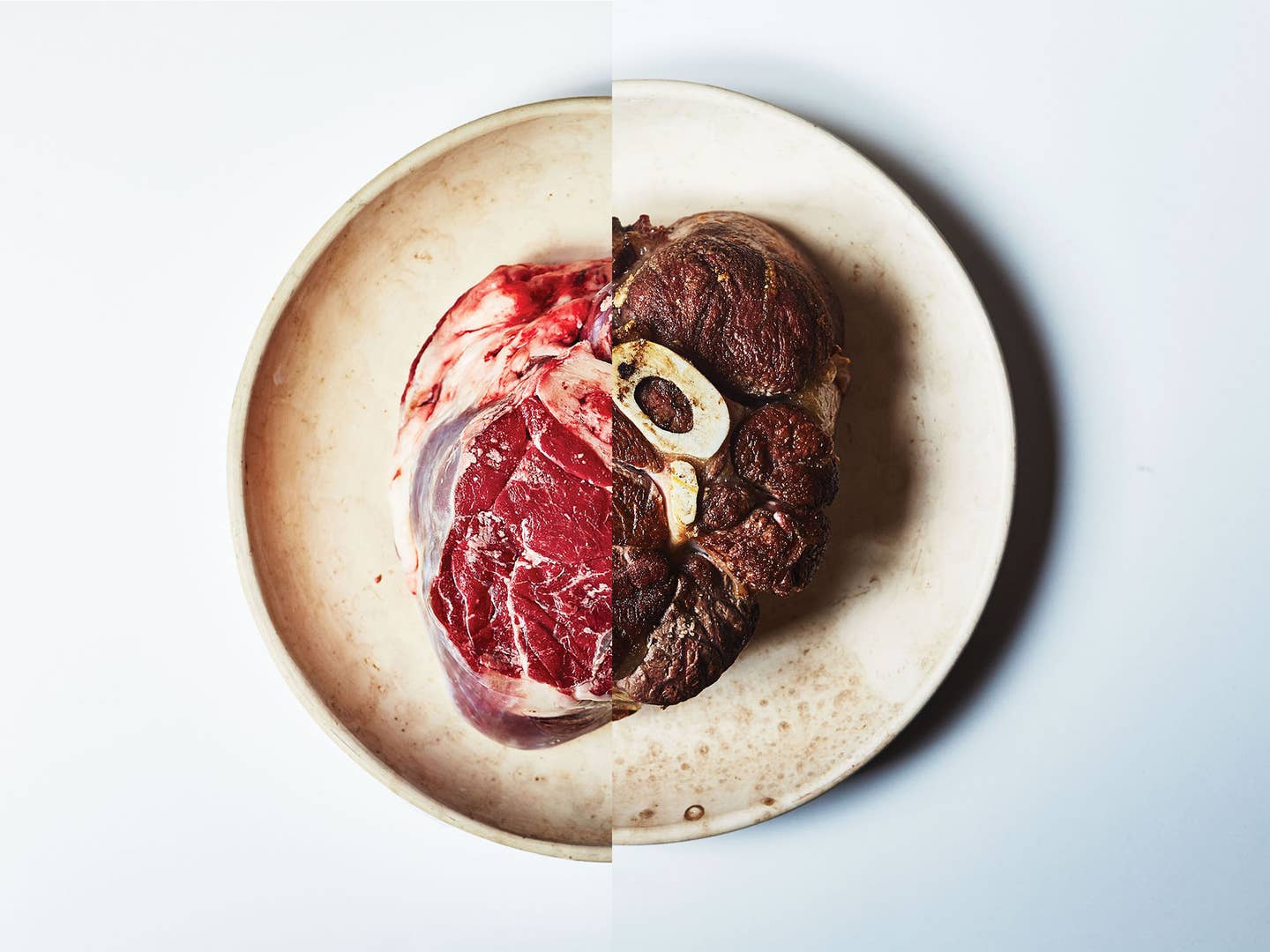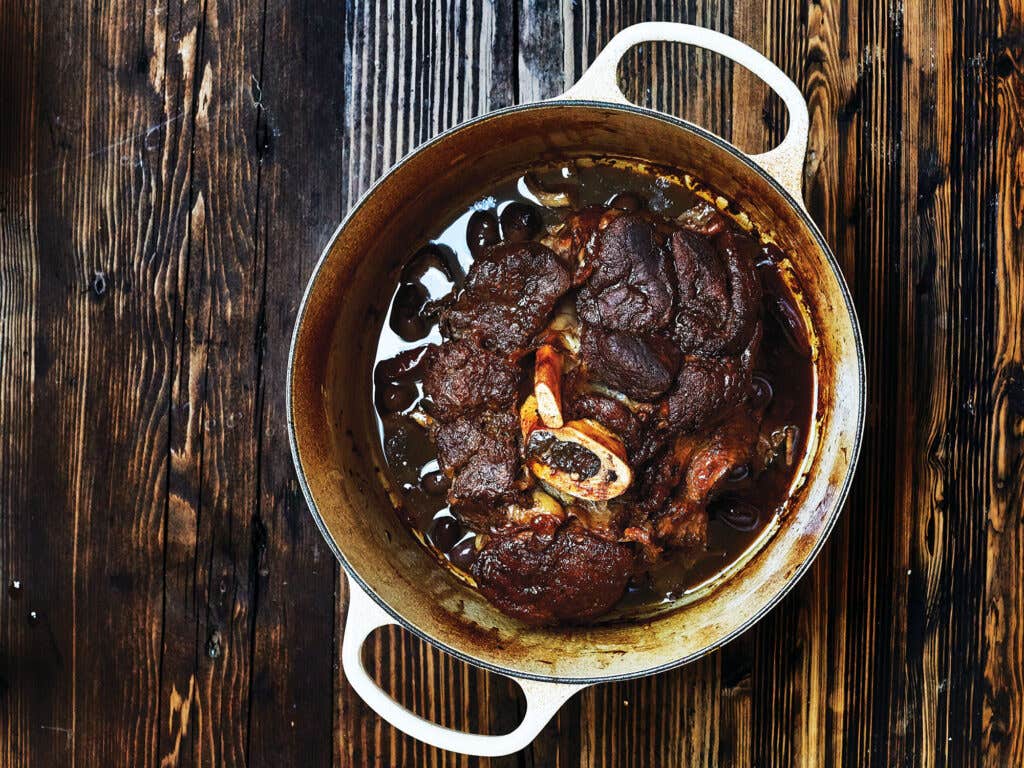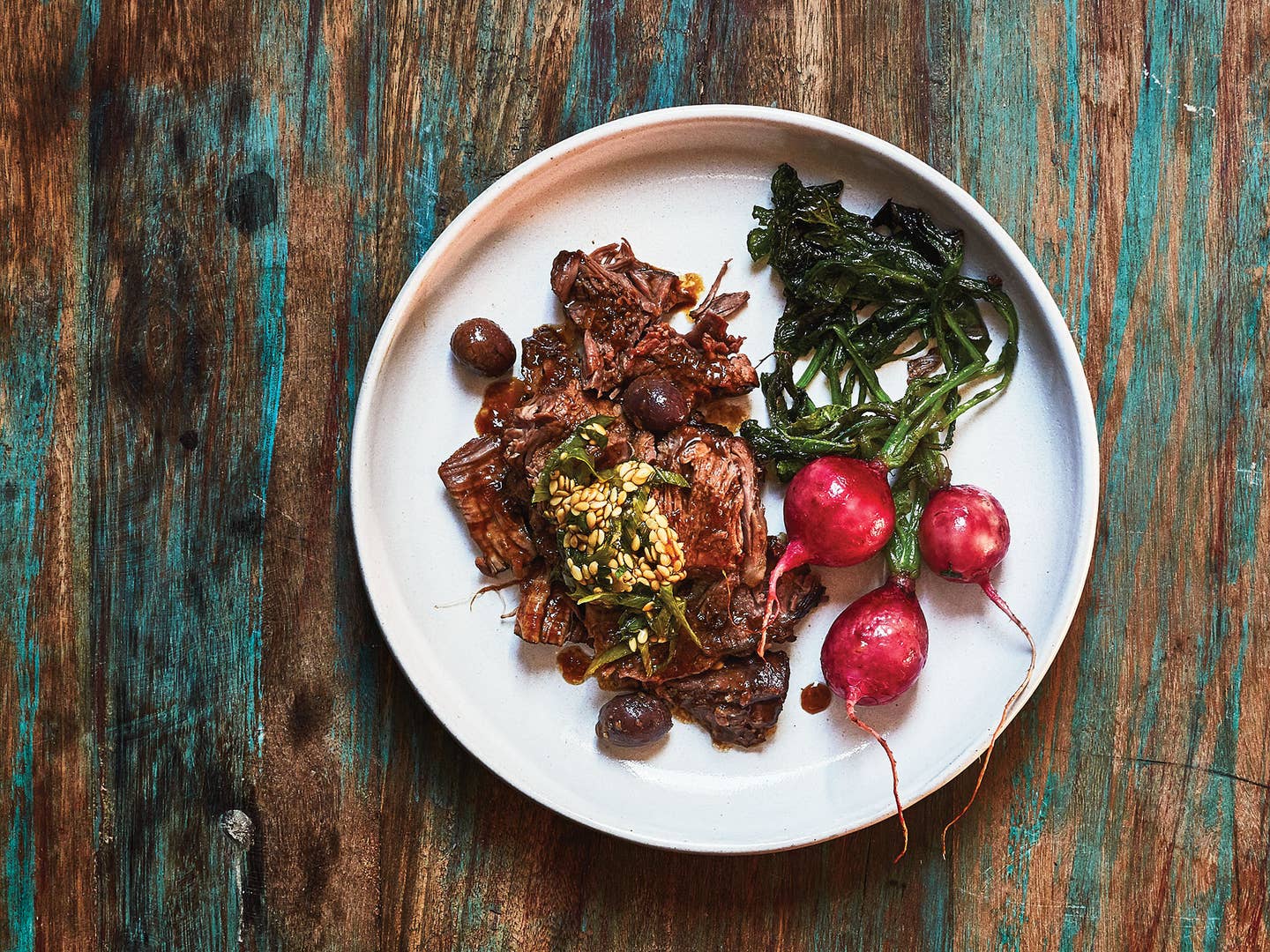
The Obsessive’s Guide to the Ultimate Pot Roast
Braising never goes out of style, but with some French technique and ingredient strategy, it can be perfected
“What were you cooking?” a neighbor asked. For hours, the rich aroma of beef braising in wine had wafted from the kitchen, under the door and into the hallway of the Manhattan apartment where we were working. Tenants waiting for the elevator had, apparently, begun to salivate. Pot roast has that effect.
Just about every carnivorous culture has a thing for braising meat, the universal method of transforming tough-but-tasty cuts into succulent morsels. Patience, more than fancy cuts, is what you need to melt connective tissue and amp up umami, the distinct meaty flavor that results when protein breaks down into glutamic acid. When done right—long and slow, with lots of patience—braising brings lesser cuts into the spotlight. And when applied to a crosscut beef shank (most shank meat ends up ground in hamburger), braising can turn an understudy into a showstopper.
Mitchell grew up on brisket, the preferred pot roast for Ashkenazi Jews the world over. A full brisket cut from the kosher-able forequarter of the cow (the hindquarter, where you get loin and rump, is difficult to kosher due to the complex laws of kashrut) weighs upwards of 10 pounds. Perfect for a family affair, a cut this size will feed 12 or more, especially when paired with traditional Jewish sides like pan-fried potato pancakes, kasha, and noodle pudding. (From their absence on the Jewish table you'd think green vegetables were difficult to kosher as well.) In his new book about Jewish food, Rhapsody in Schmaltz, Talmudic scholar and humorist Michael Wex reminds us that until Texans started smoking it, brisket was "a pariah cut dear only to those who had no other choice." And yet, with enough onions, garlic, tomato products, seasonings, and cooking liquid—which, occasionally, might have included a can of Coke—Mitchell's mother could make a brisket that her children considered as toothsome as filet mignon.
In Provence, Laurent's grandmother made a daube of wild boar, which hunters would parcel up for the neighbors to share. She marinated the (unkosher-able) wild pig's meat at room temperature in a wine-filled, screen-enclosed garde-manger for days before adding aromatics. She'd then seal it in an earthenware daubière, the distinctive vessel with an indented cover. Into the lid's indentation would go water to mitigate the heat and evaporation produced by a wood fire, allowing for an even, moist braise.
Historically, anything cooked in a daubière—artichokes, celery, goose—would be considered en daube, though sometime in the beginning of the 20th century, beef became the default. In The Food of France, Waverley Root notes that, surprisingly, white wine was traditional in daube de boeuf à la provençale. But more on that later.
Long before then, sometime in the 18th century, a heavily spiced, red wine-soaked braise known as boeuf à la mode (essentially, "stylish beef") became fashionable in France, so much so that it was exported to England and to America, where it became known as alamode beef. Hannah Glasse's largely plagiarized classic British cookbook from 1747, The Art of Cookery Made Plain and Easy, includes a recipe that calls for a leg of mutton or piece of beef, wine or ale, mushrooms, and an assortment of spices. In fact, spices may be responsible for the dish's rise to fashion; the 18th-century spice trade brought exotic flavors from abroad into the limelight. By 1796 when Amelia Simmons wrote American Cookery, America's first cookbook, alamode had become a verb. Simmons gave directions for two different techniques to alamode a round of beef. One involved curing the meat with saltpeter and steaming it for several hours (similar to corned beef); the other bathed the joint in claret and sealed it in a pot with bread dough and braised it for hours and hours.
To update the traditional pot roast—to make it more stylish, if you will—we chose a beef shank, crosscut like osso buco. It's an impressive piece of meat, large enough to feed up to six, that any good butcher should be able to provide. We use white wine, whose acidity renders the finished dish bright and balanced. To build layers of flavor, the meat is put in a covered pot to which the wine is added in small quantities and reduced to almost dry before adding more. The steam and the acidity help tenderize the meat. A rich stock and aromatic vegetables are added last to keep the flavors distinct and true. Then the whole thing goes in the oven to braise until the meat becomes perfectly tender.
Like a couture dress, every piece of meat takes some personal attention; the exact length of cooking time and seasoning required differ from one to the next. But the end result is always à la mode.
Keys to the Ultimate Braise

The Cut
Chuck roast or chuck shoulder is a common choice for pot roast. In this case, however, we used a crosscut beef shank, which often ends up as ground hamburger. It usually requires that you special order it, but any good butcher should be able to provide this cut upon request.
Braise and Reduce
Braising can be as simple as placing all of your ingredients in a pot, covering it, and cooking over low heat until tender. But to bring out the best of this beef shank, we braised in stages. To create a concentrated reduction and introduce fat-cutting acidity, we added white wine in stages (red can add meat-toughening tannins and muddy flavors). With each addition, the pot is covered to produce an acidic steam, which helps break down collagen and connective tissue and build flavor.
Standards of Stock
Following reduction, a rich bouillon rounds out the braise's flavor, adds complexity, and boosts the aromatics in the braise itself. A stock is enriched by being boiled twice with meat and aromatics, then strained. In traditional French kitchens stocks can be reboiled two, three, or four times. To save time, effort, and ingredients we start with a store-bought stock. The short ribs used for the second boil can be removed and reserved for another meal, seasoned, seared in hot duck fat or oil, and served with a strong mustard dressing, or taken off the bone and tossed into a meat sauce or salad.
Aromatics and Acidity
Shallots, chiles, olives, herbs, and mushrooms added to the final braise bump up the dish's umami—a funky flavor that adds depth and complexity, and is found in foods like sundried tomatoes, dried wild mushrooms, soy sauce, and miso. A little fresh passion fruit adds additional acidity and complexity without the distraction of lemon or other citrus. A splash of good apple cider vinegar would also work.
Relish and Radishes
We wanted accompaniments that would cut through richness and provide texture. Bright acid and fresh vegetables are key. We incorporated herbs and scallions into a salty, tart relish bulked up with sinewy, slippery flaxseeds. Likewise, crunchy roasted radishes, with their bitter greens intact, balance the luscious flavors of braised meat.
Braise Like a Pro
The Ultimate Pot Roast
A low and slow braise is the best way to transform tough cuts of meat into fork-tender morsels. This version, made with a crosscut whole beef shank, is cooked in white wine and rich homemade beef bouillon layered with vegetables and aromatics for added complexity. Crunchy roasted radishes and a funky flaxseed, herb, and vinegar relish balance the pot roast’s richness with acidity and texture. Get the recipe for The Ultimate Pot Roast »
Keep Reading
Continue to Next Story











